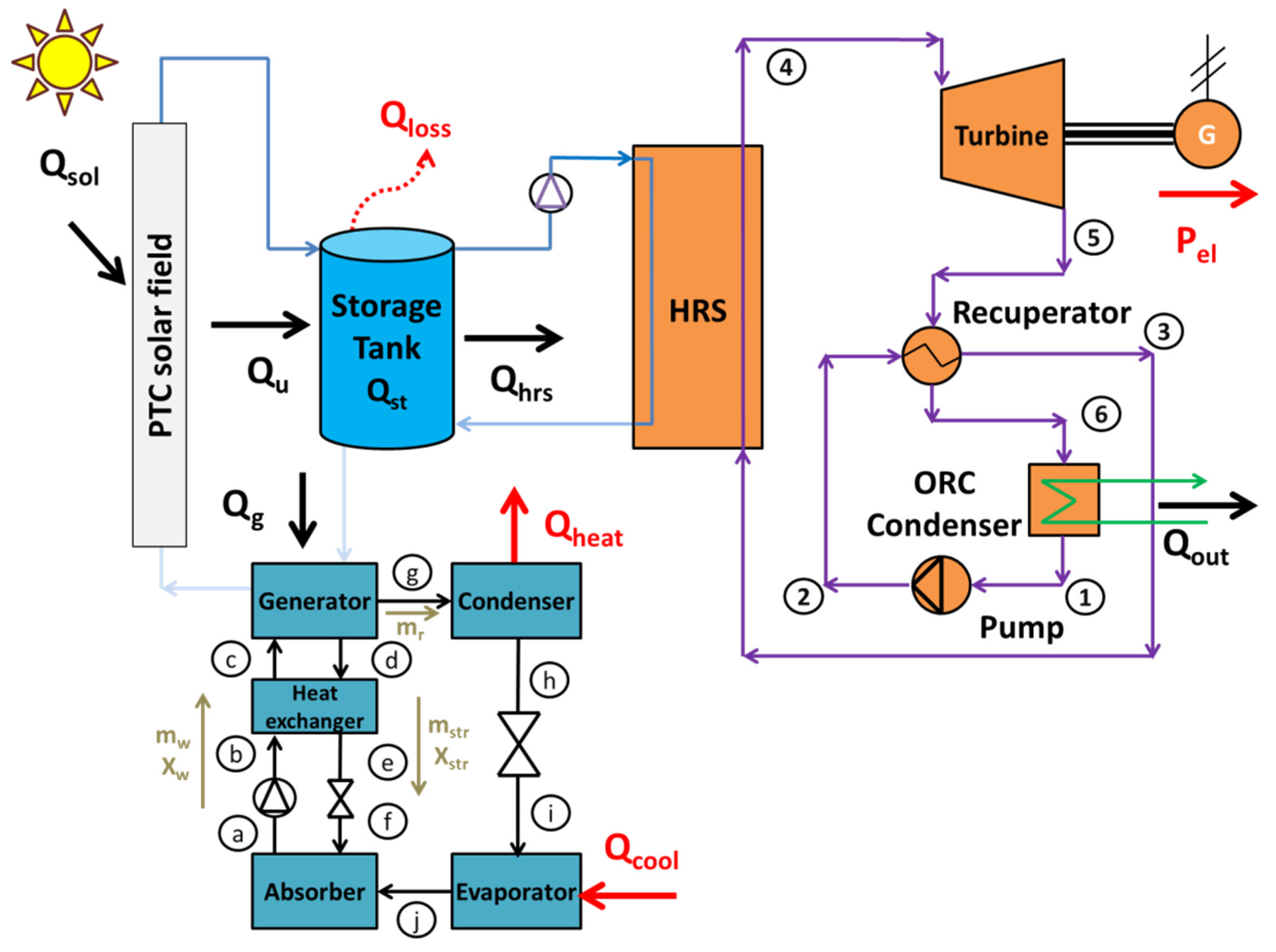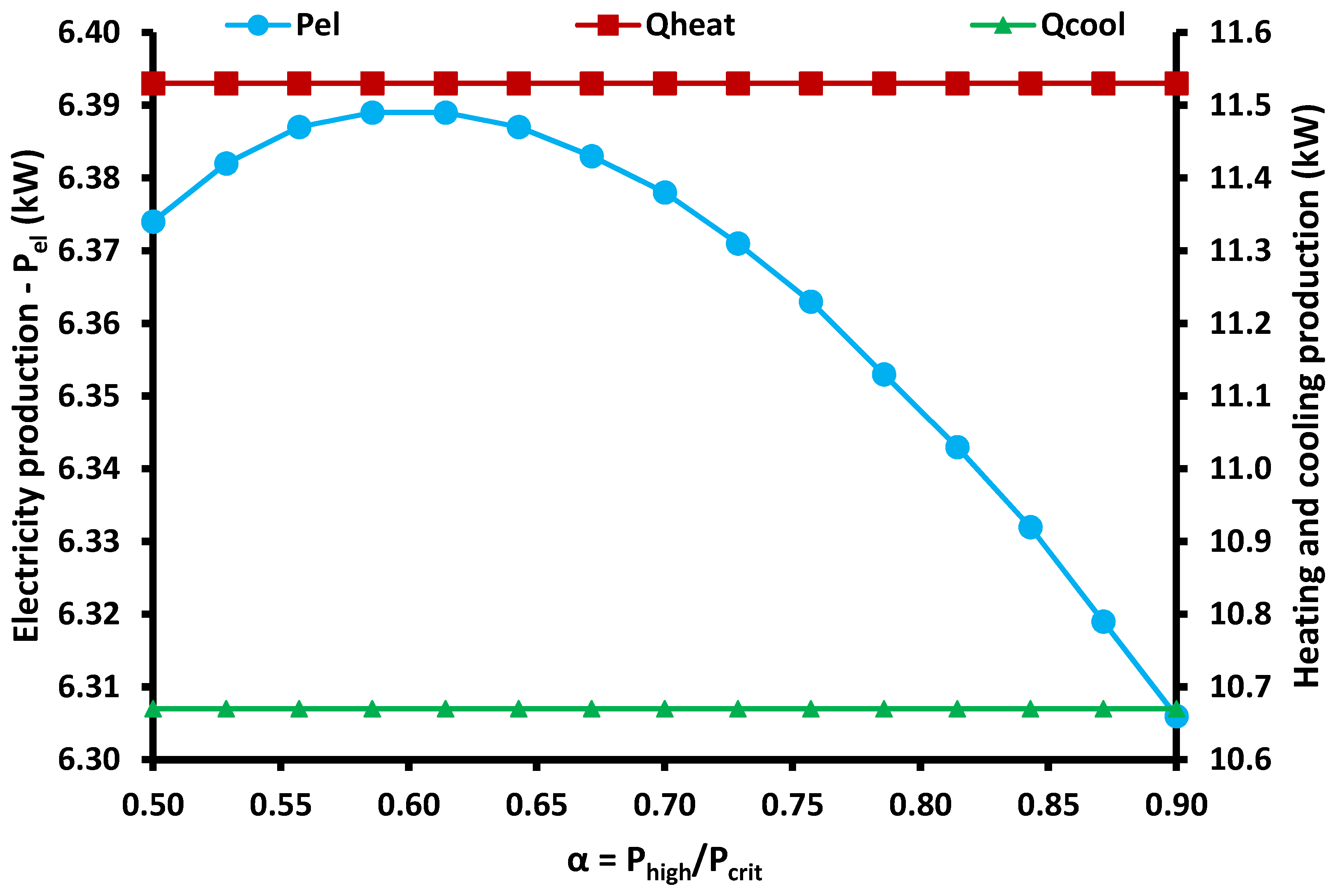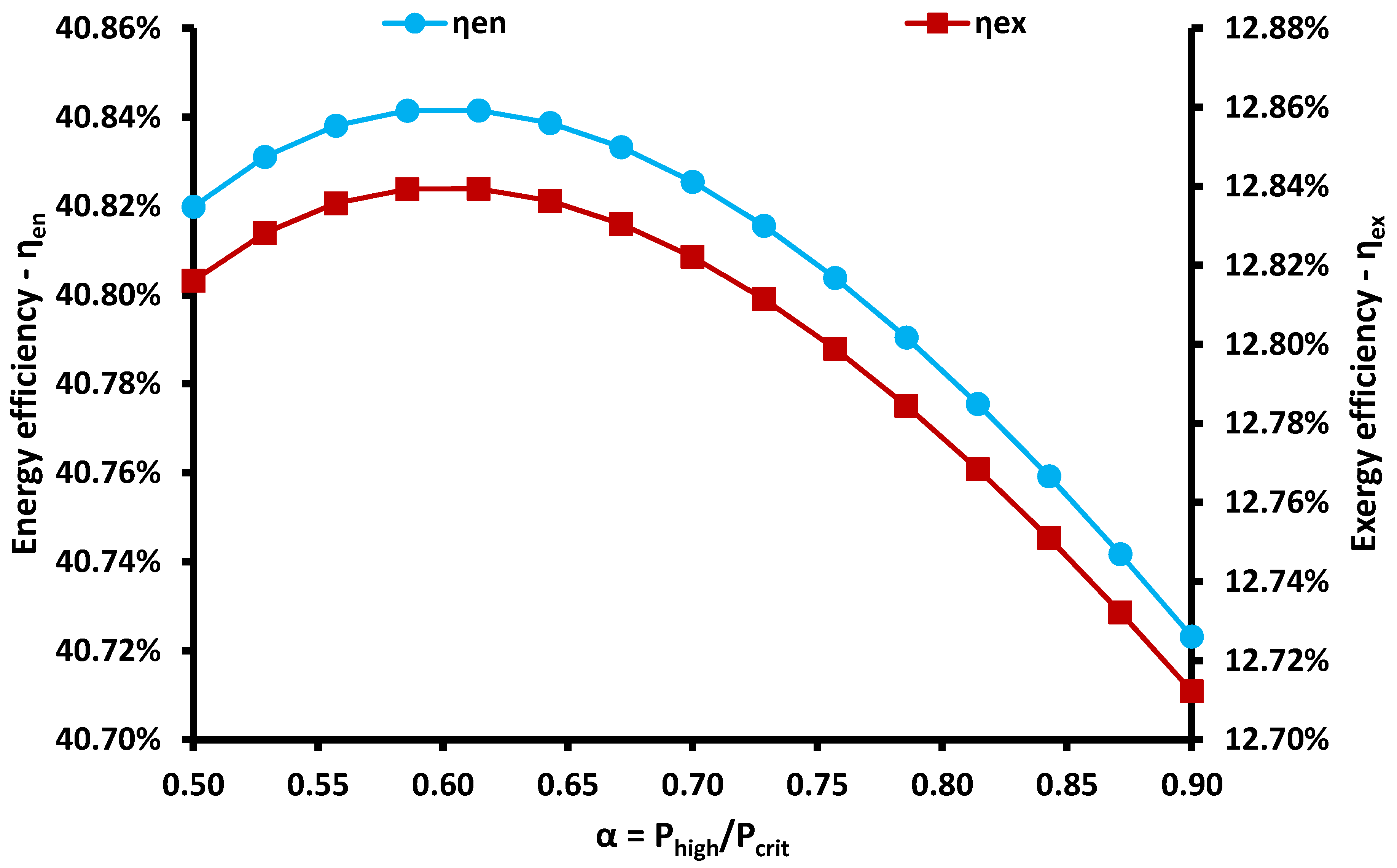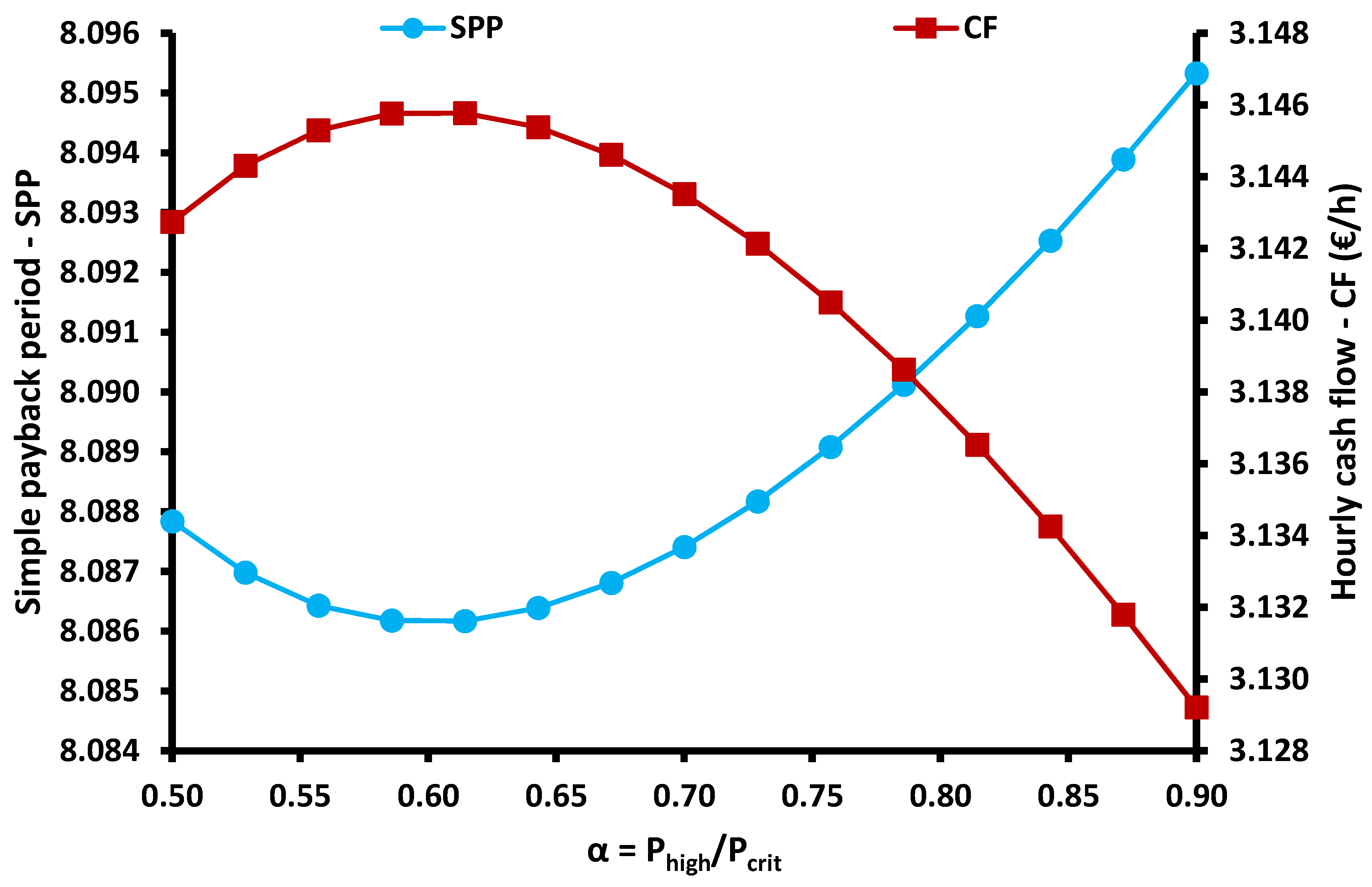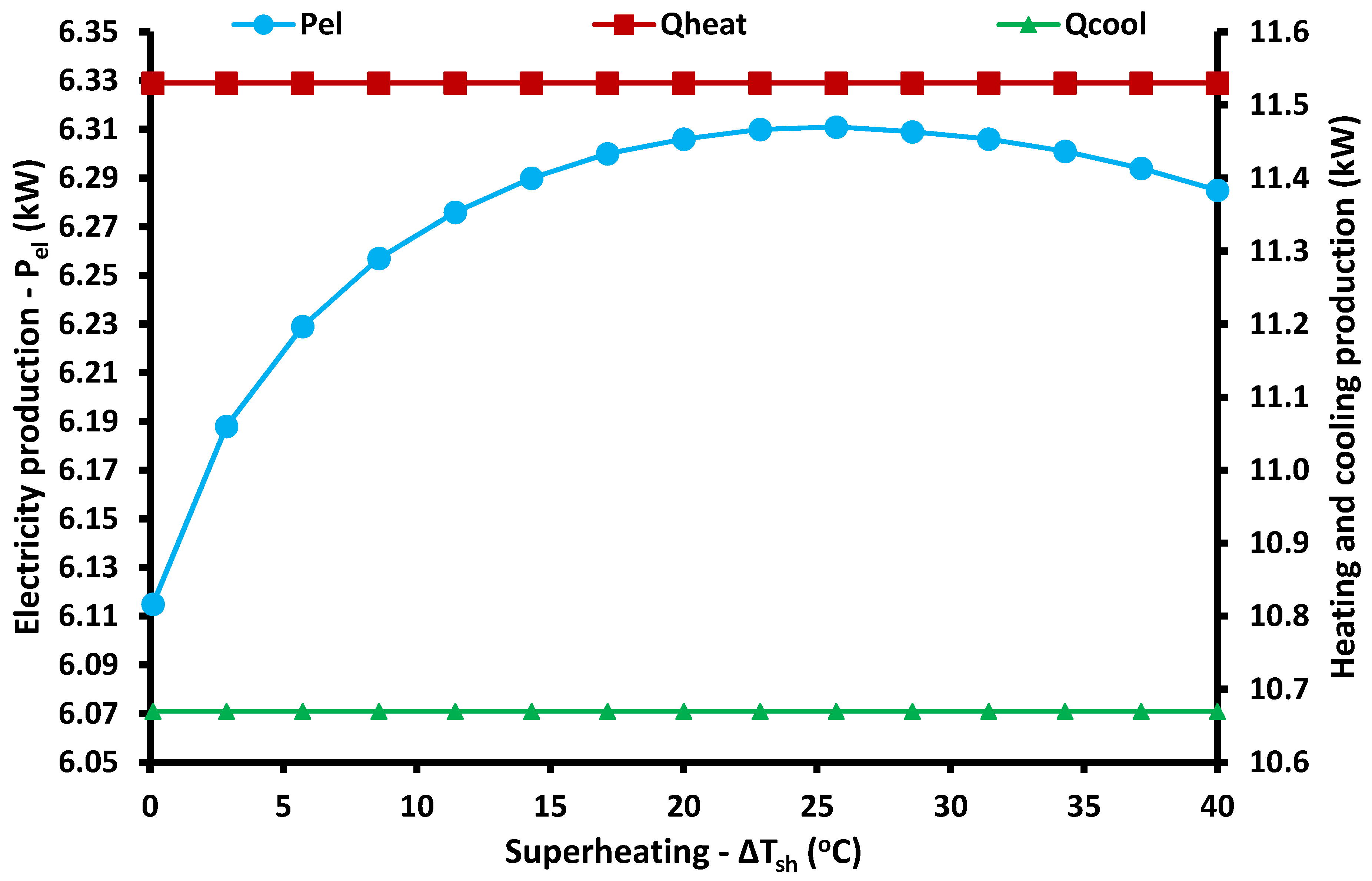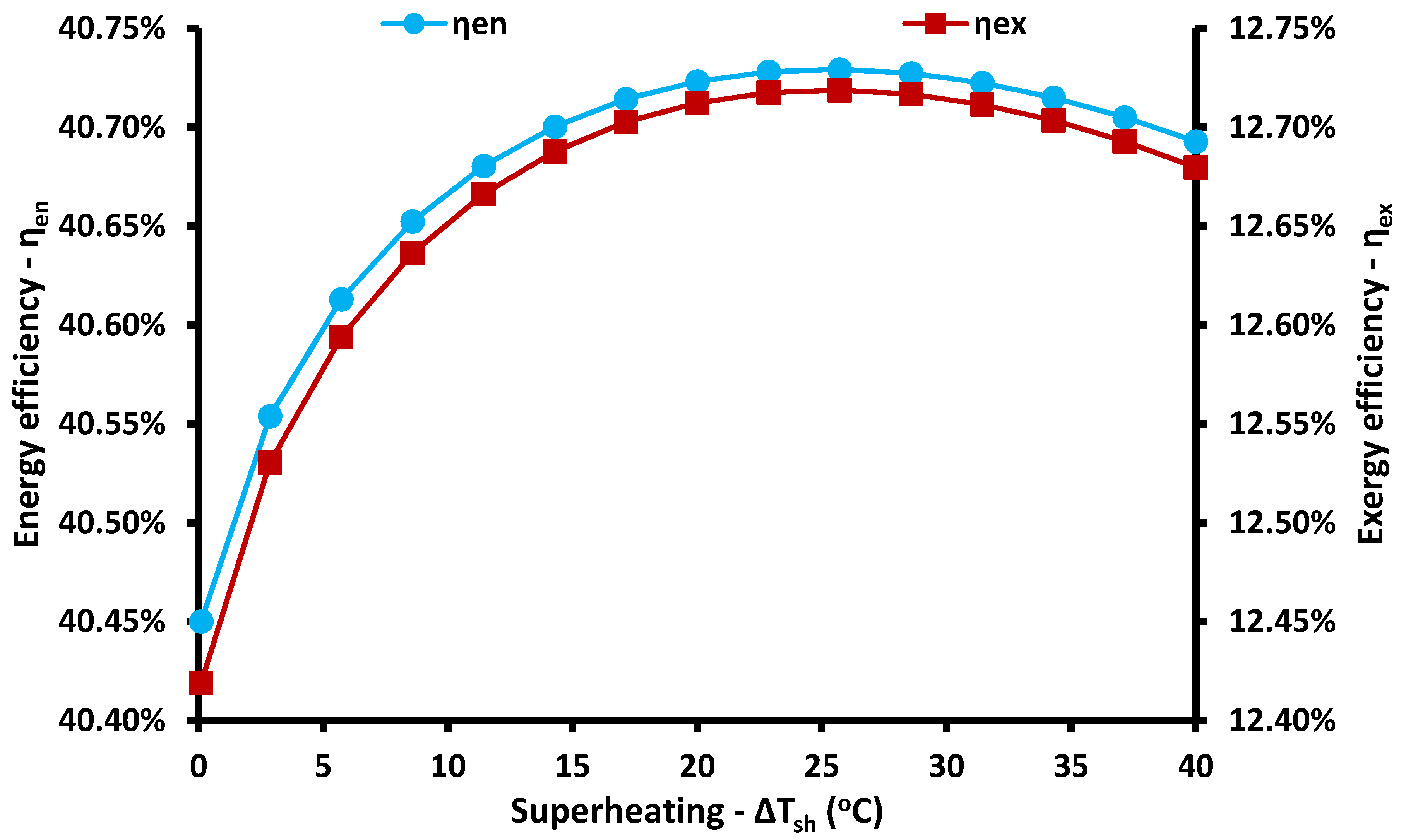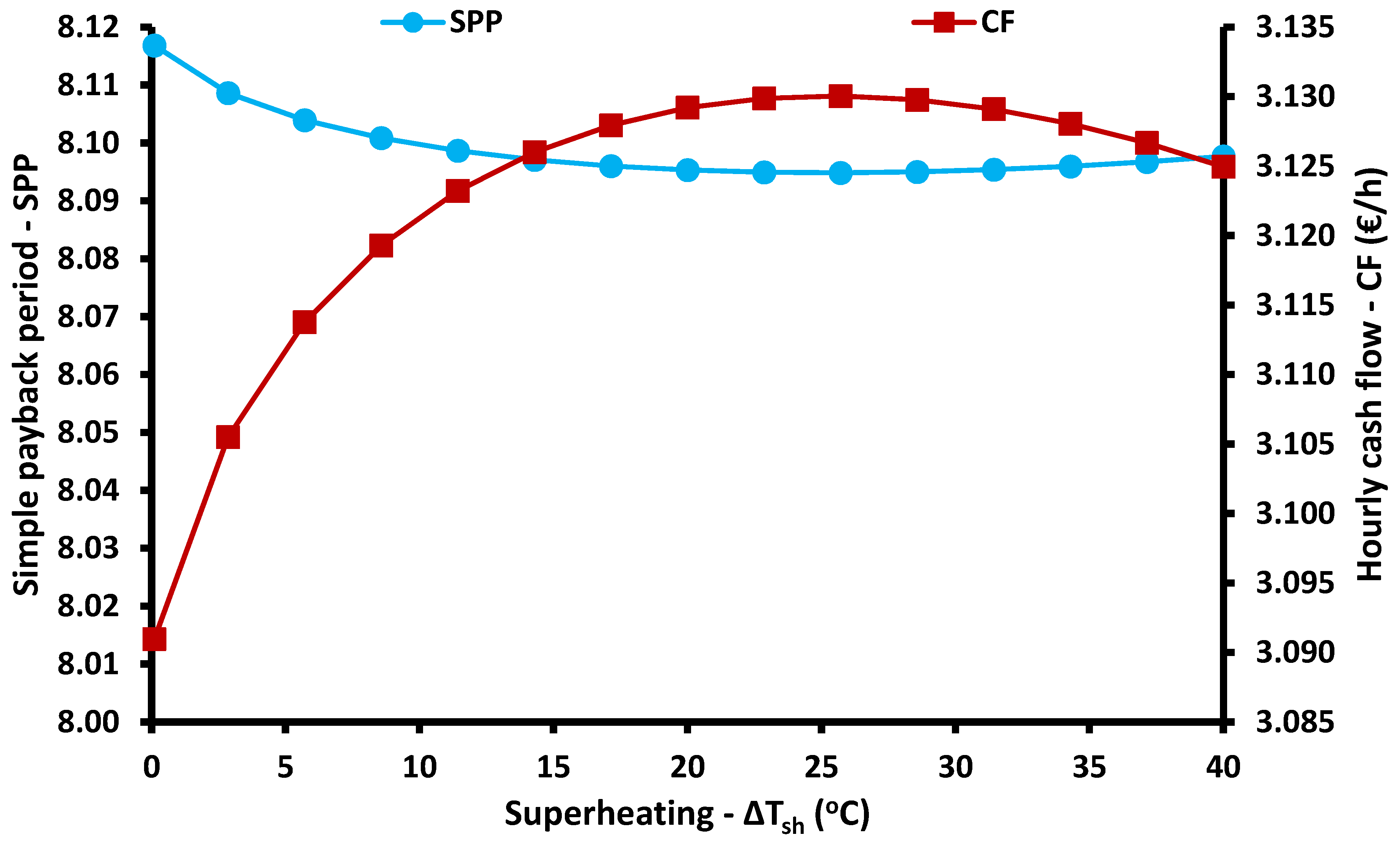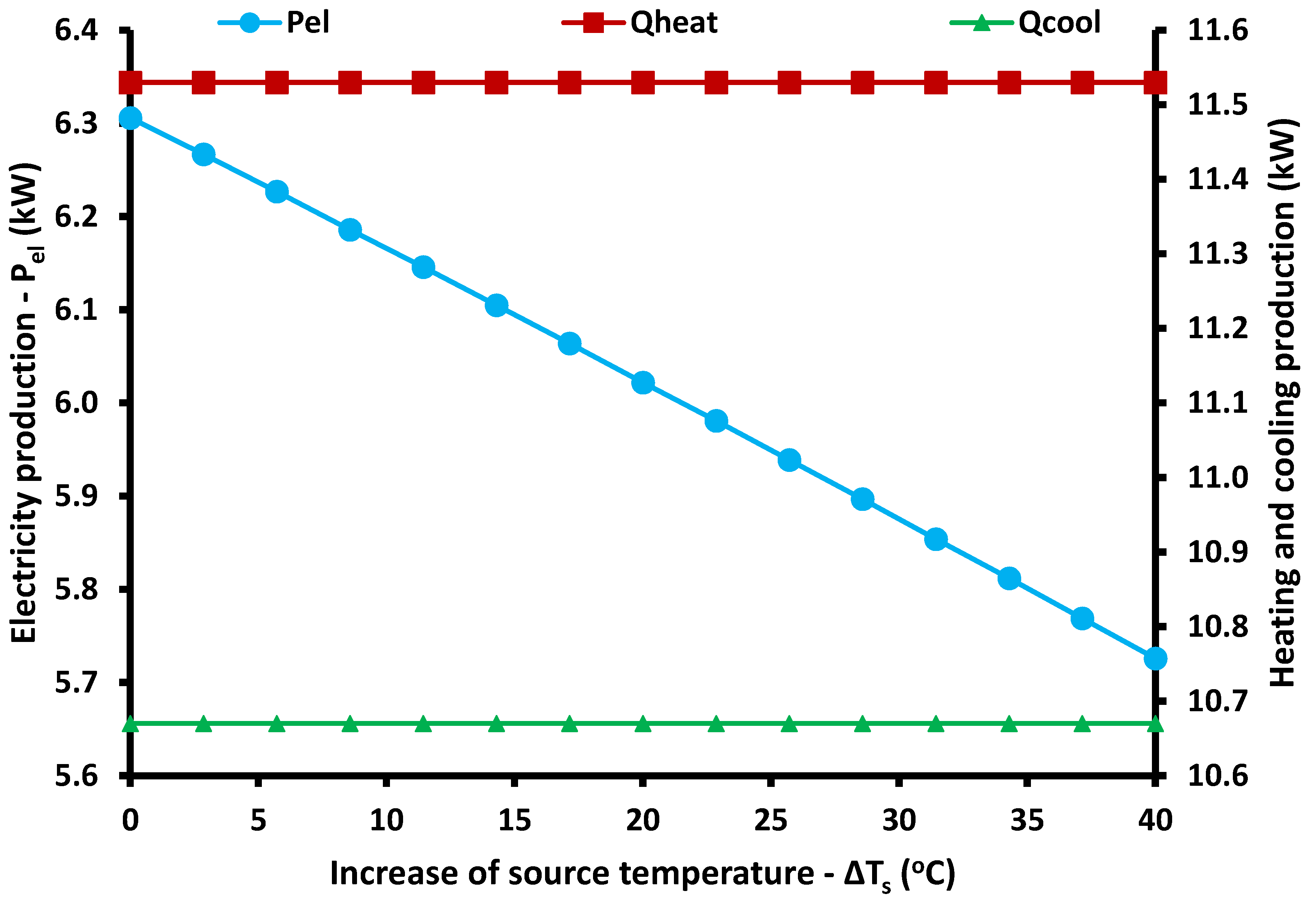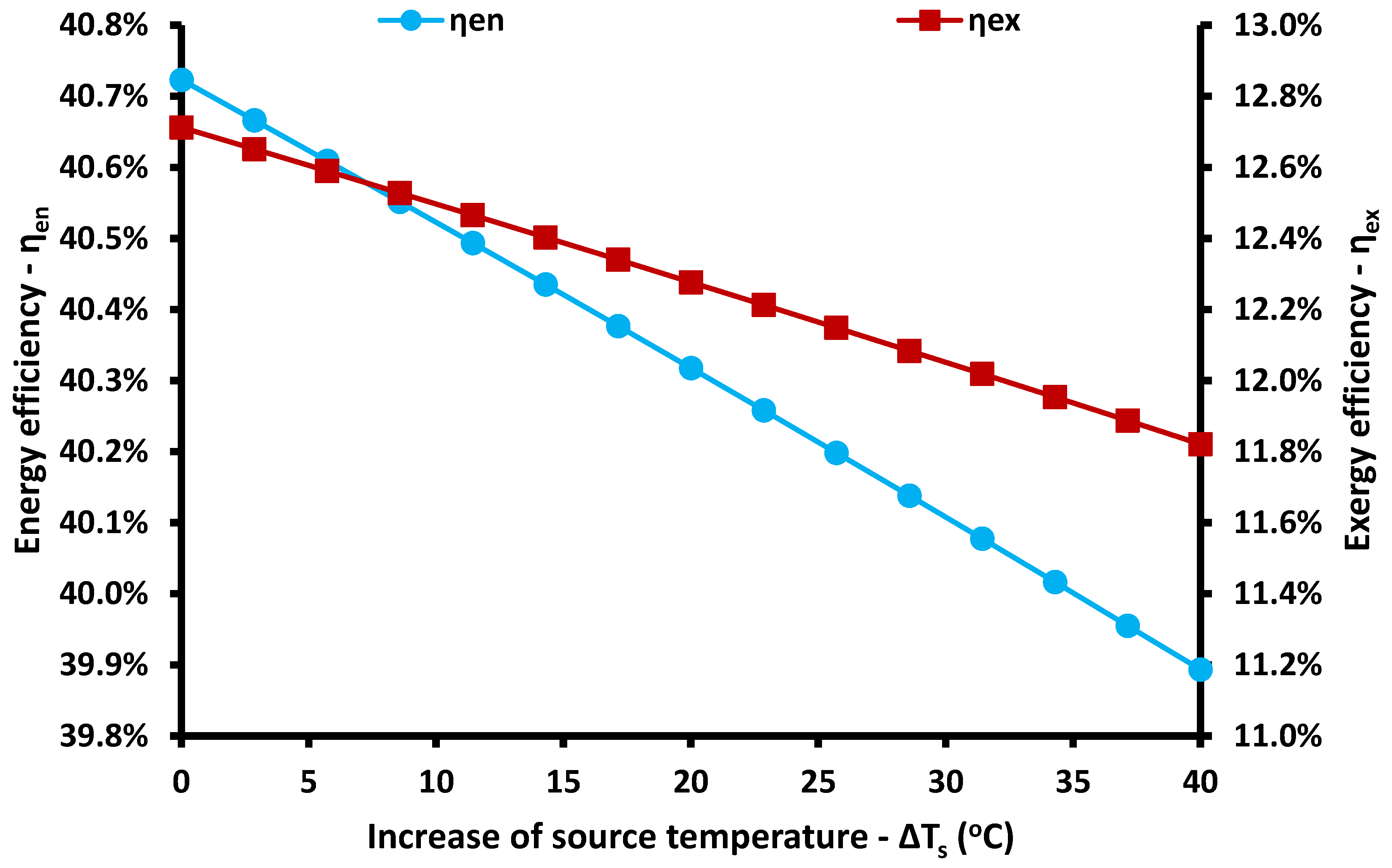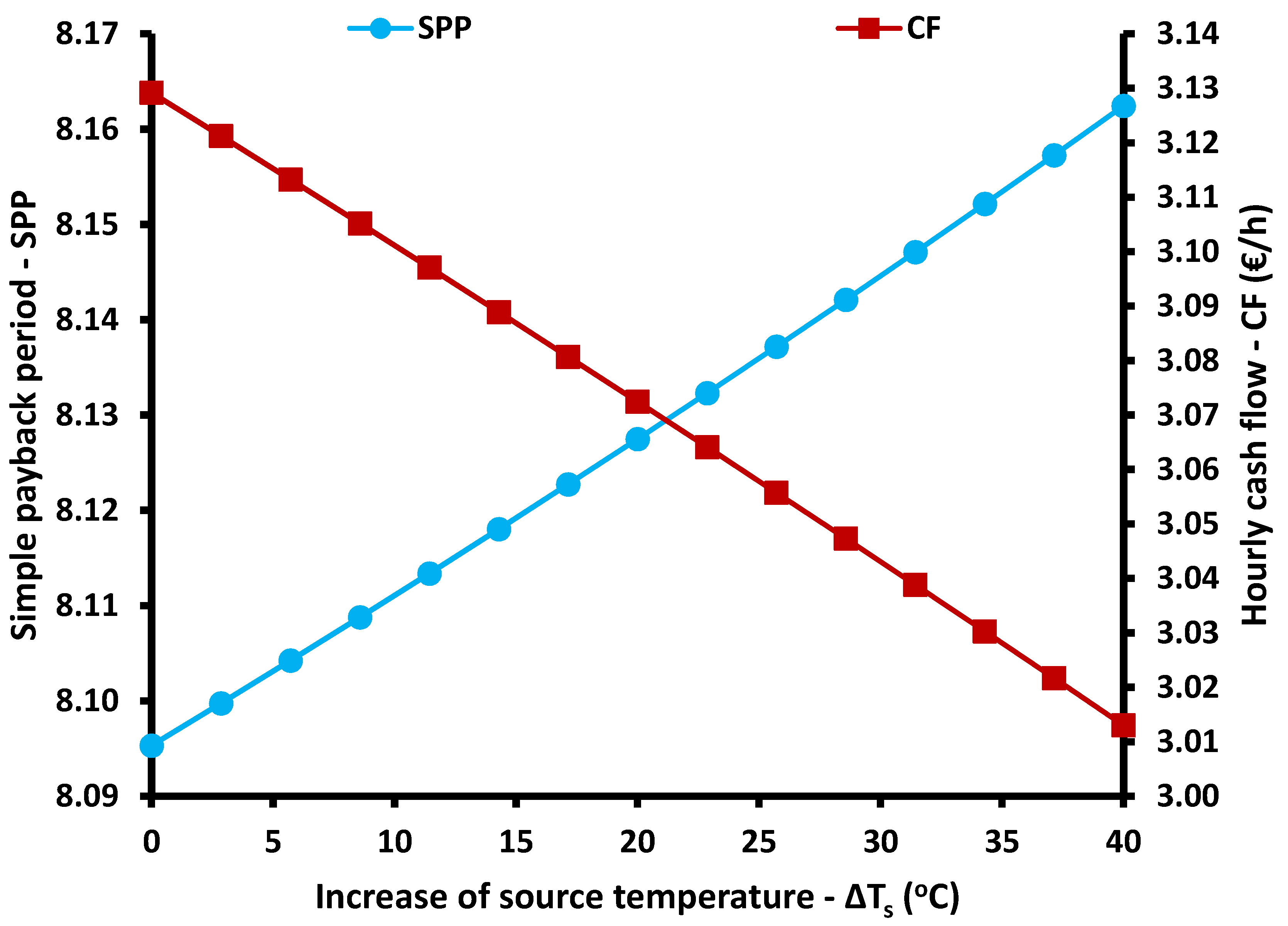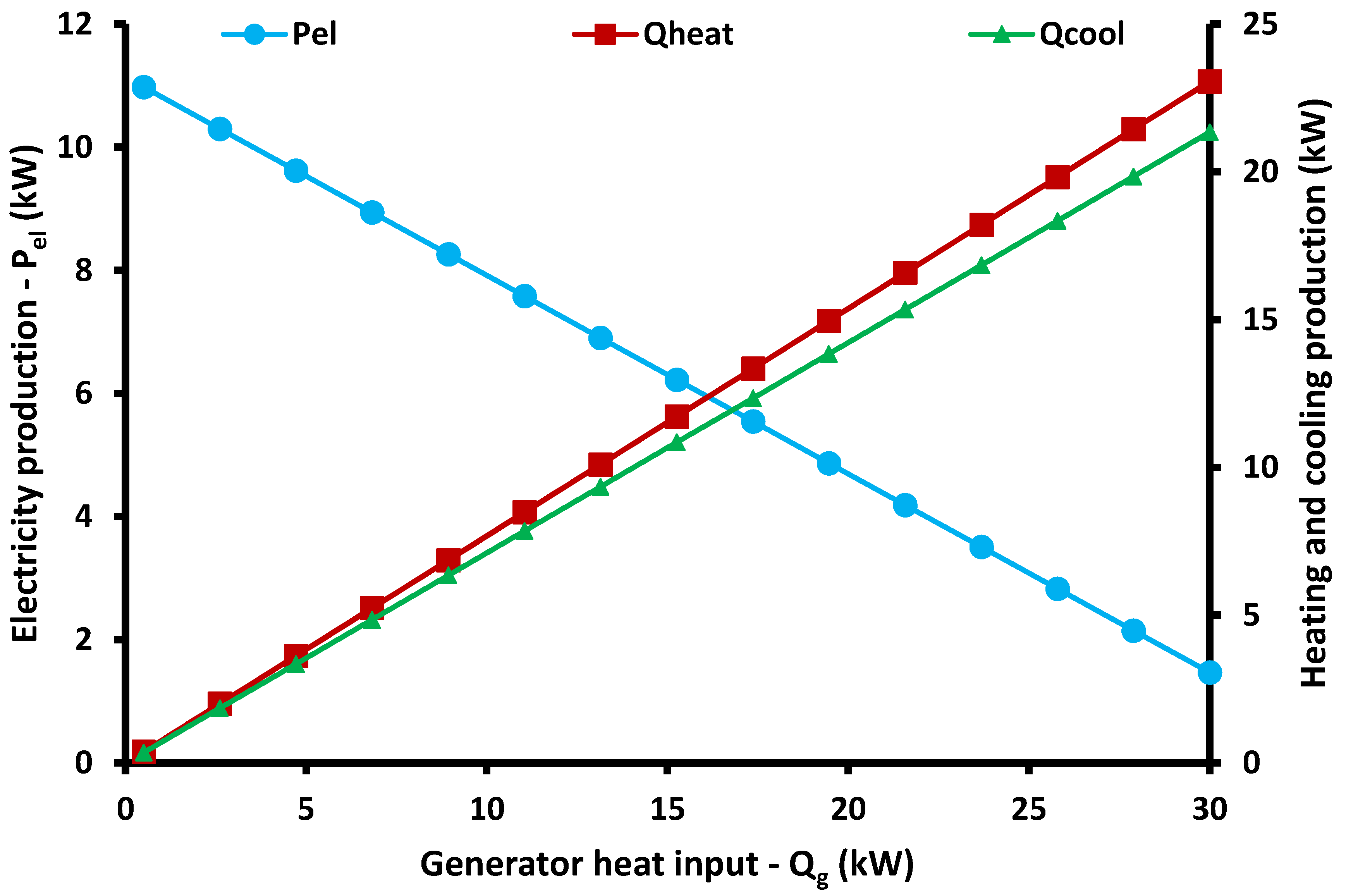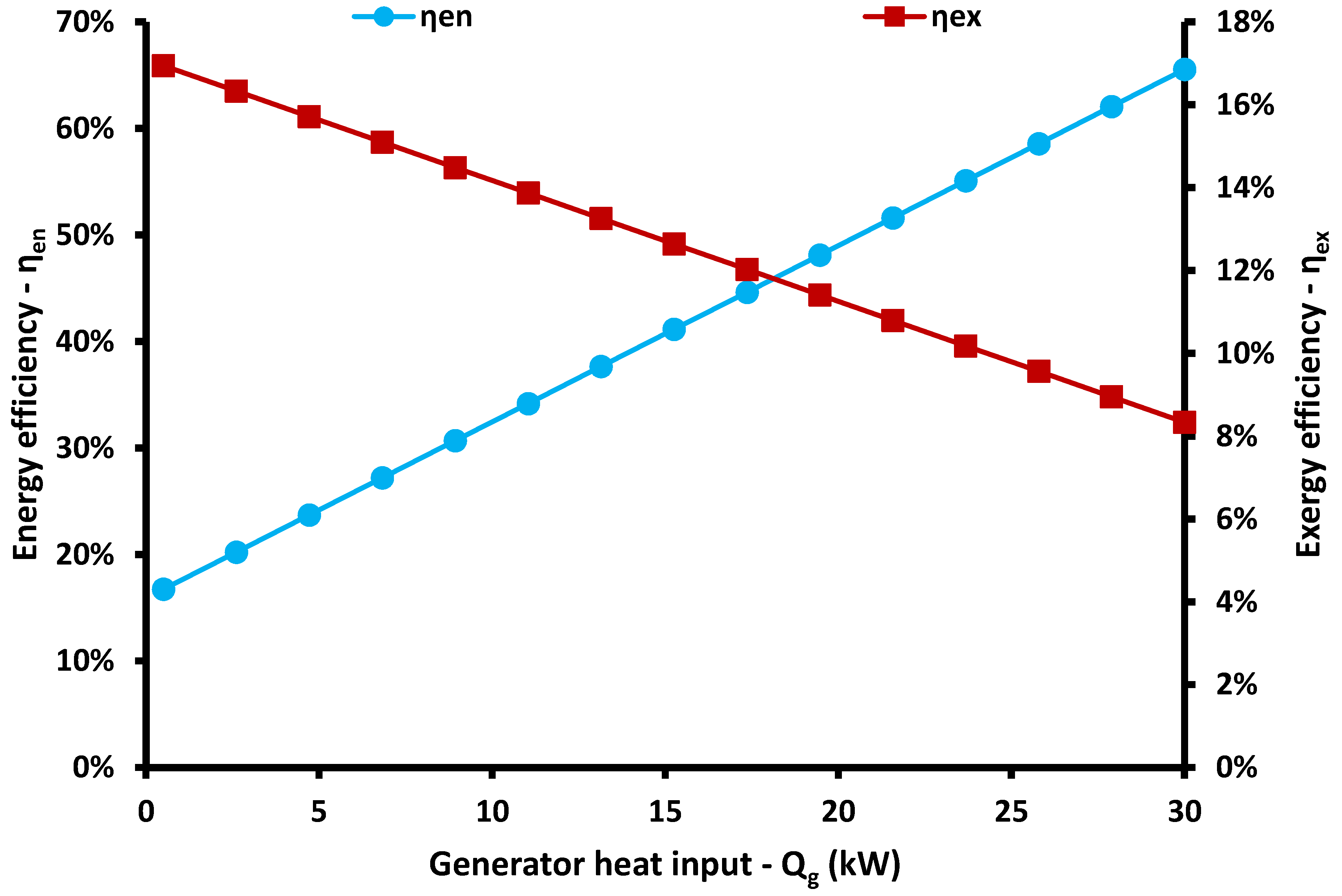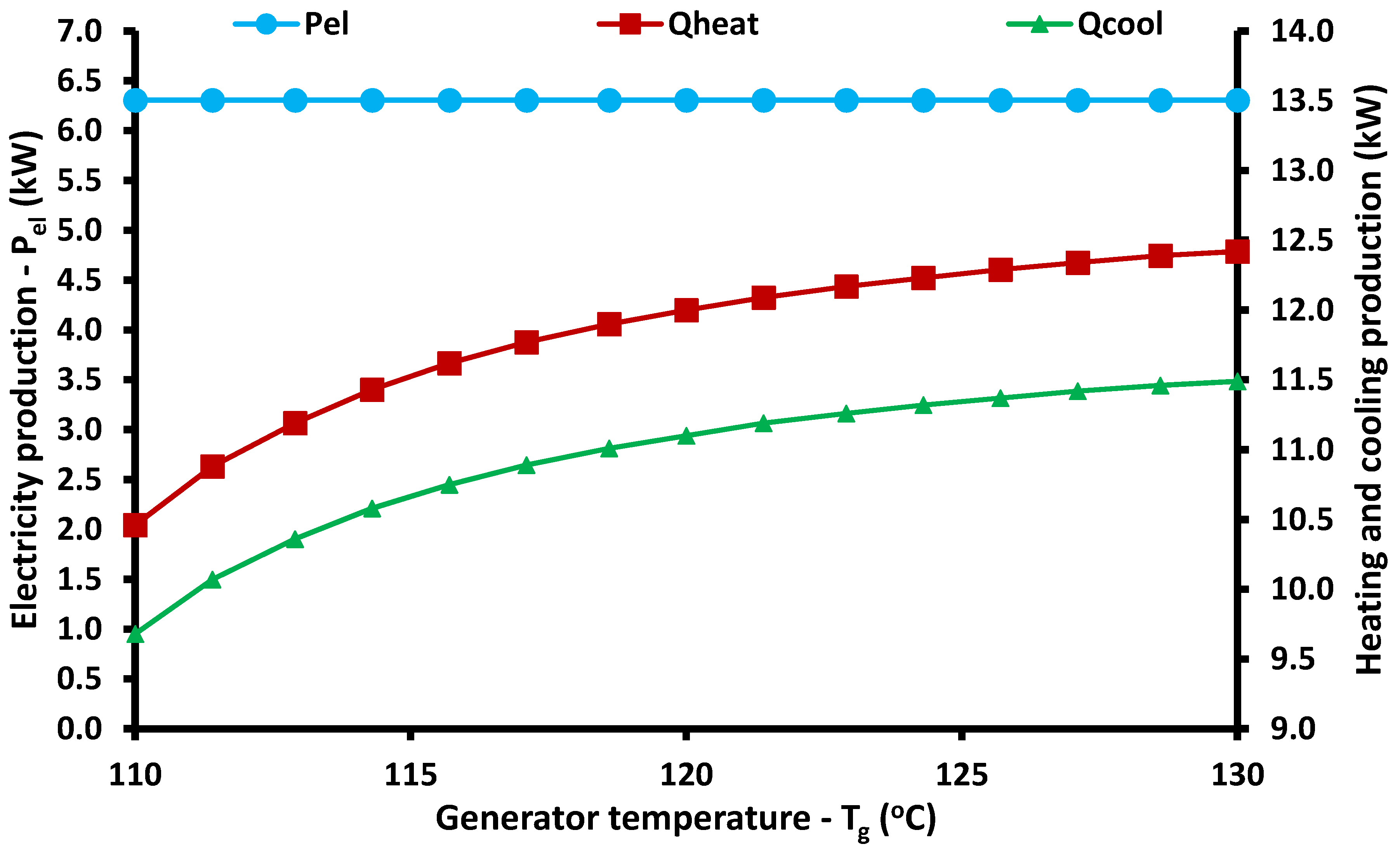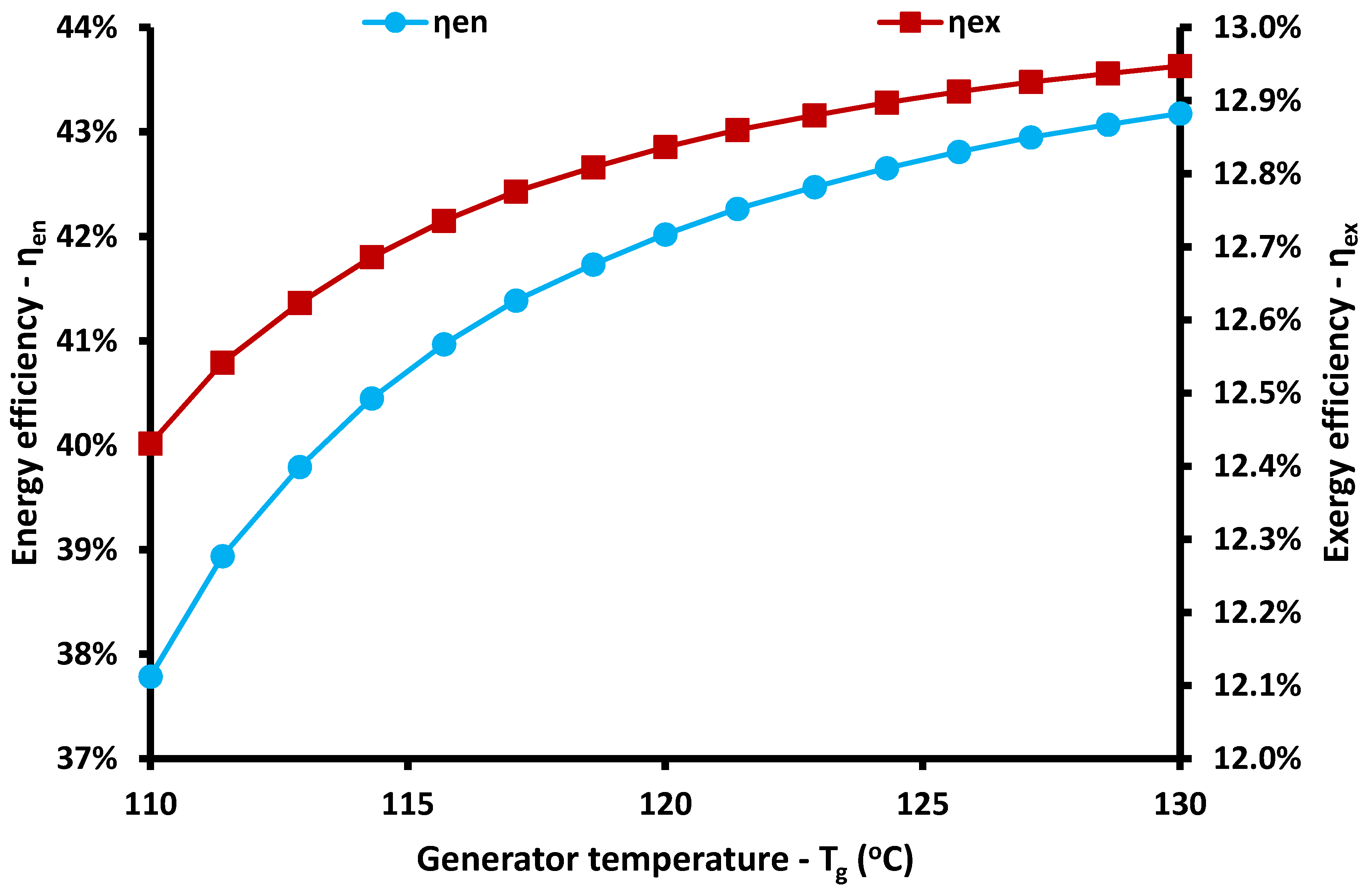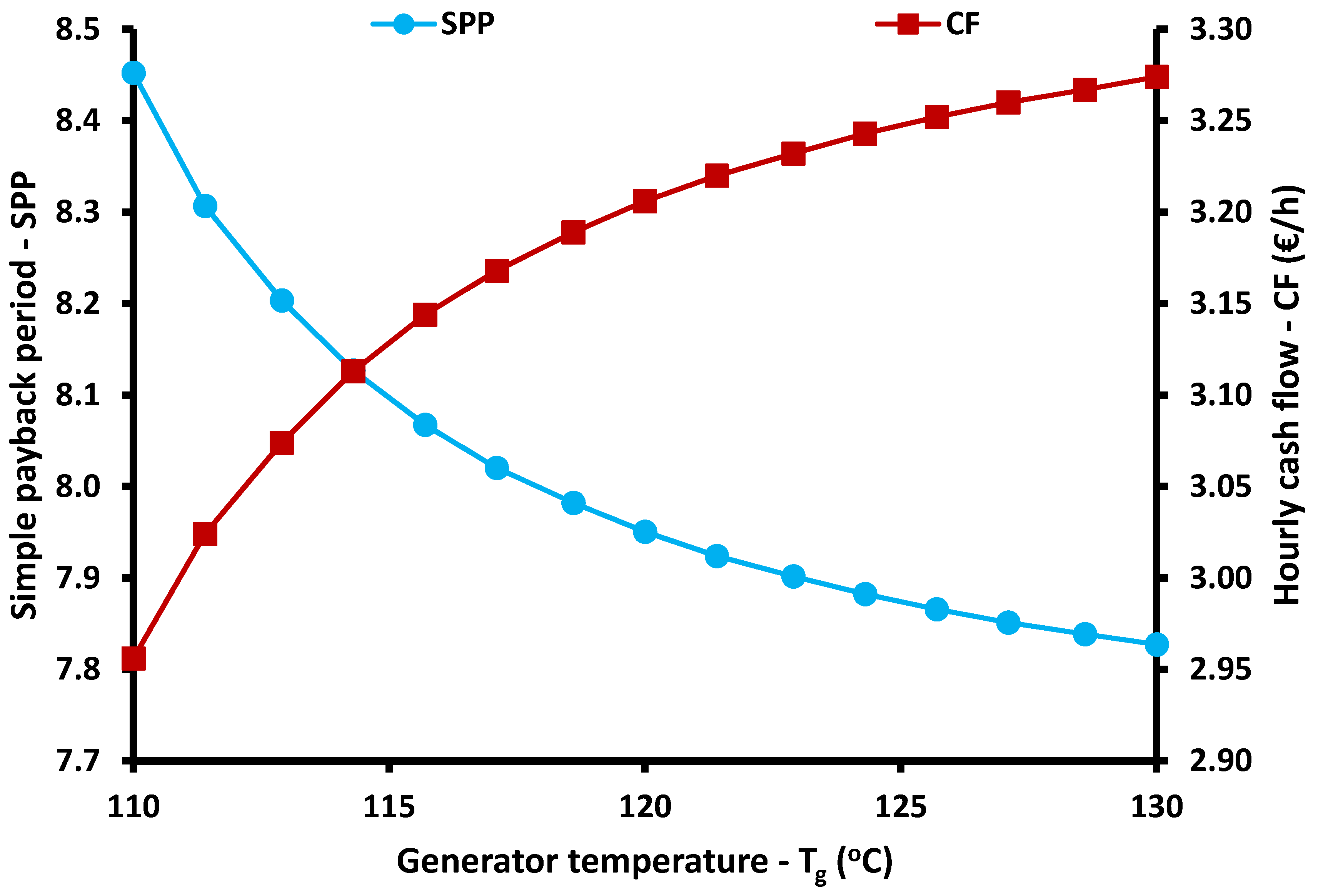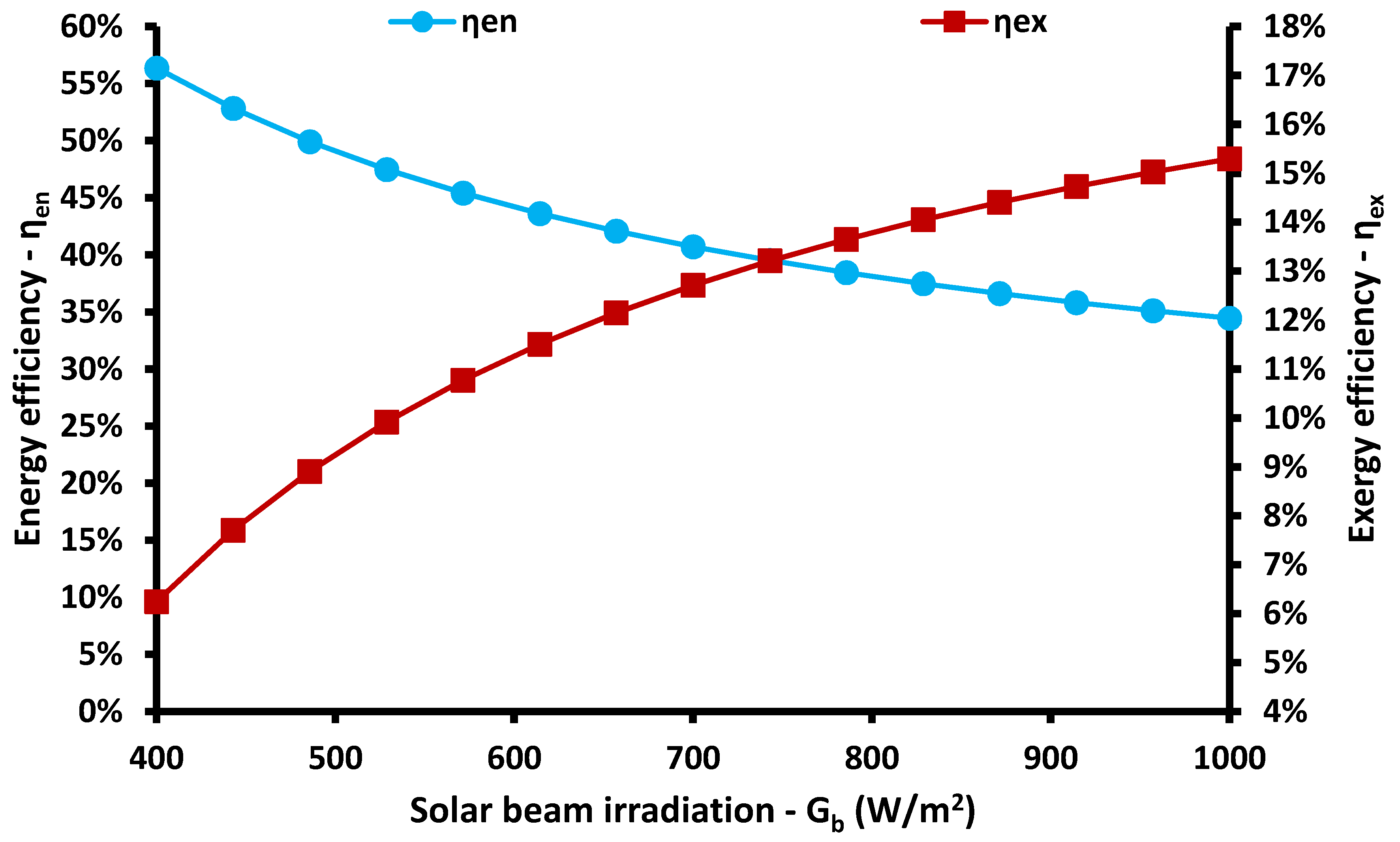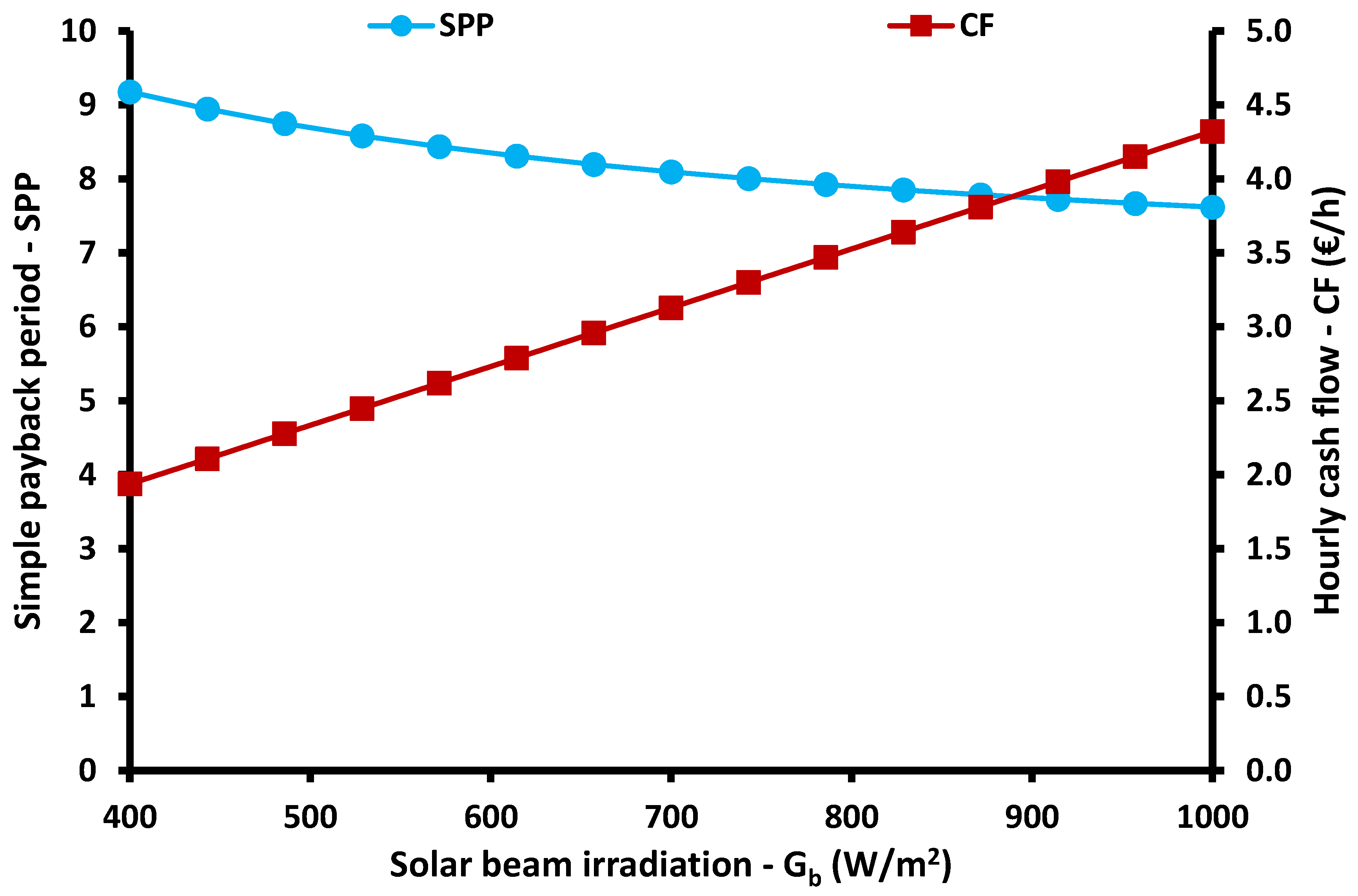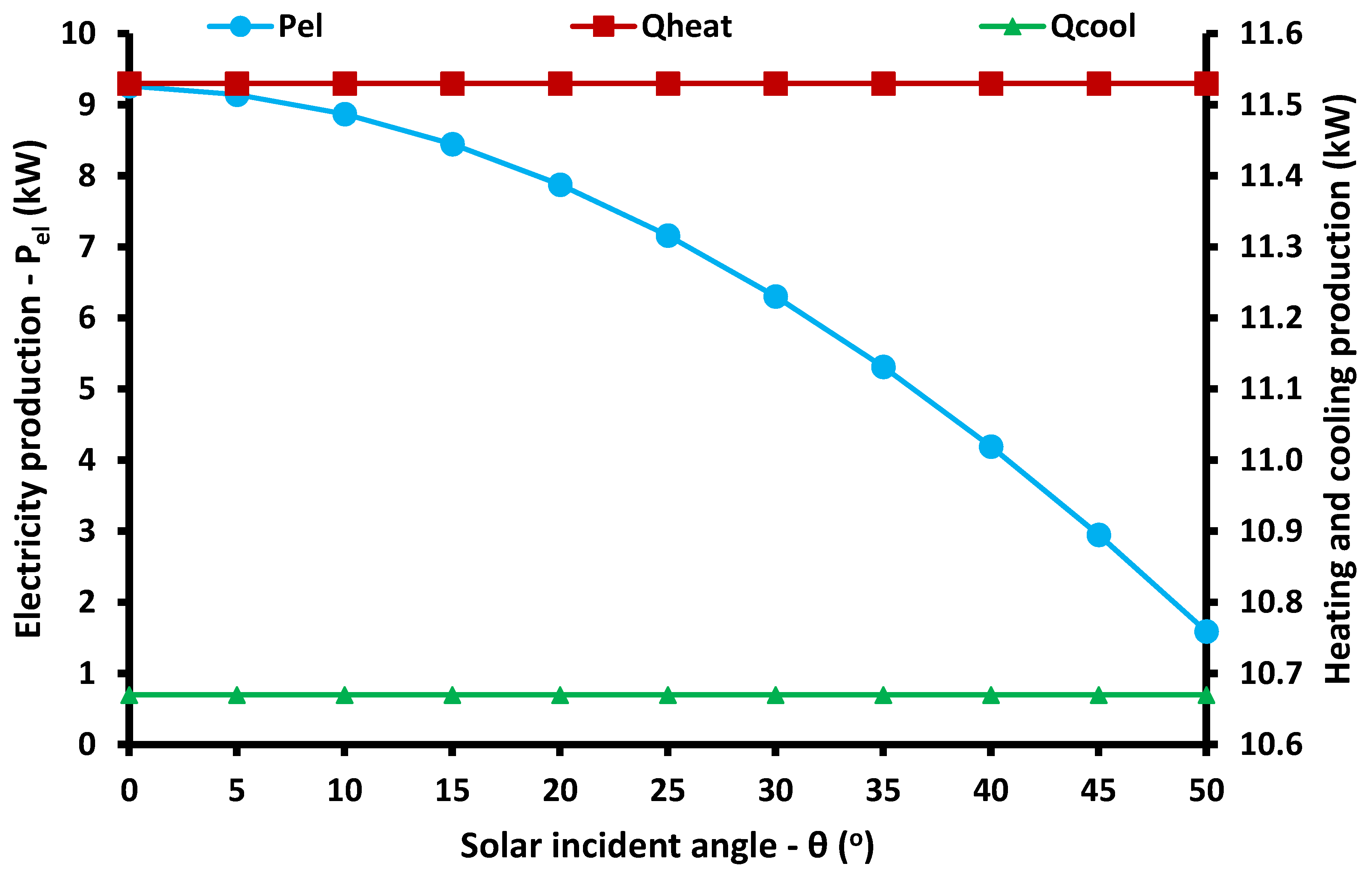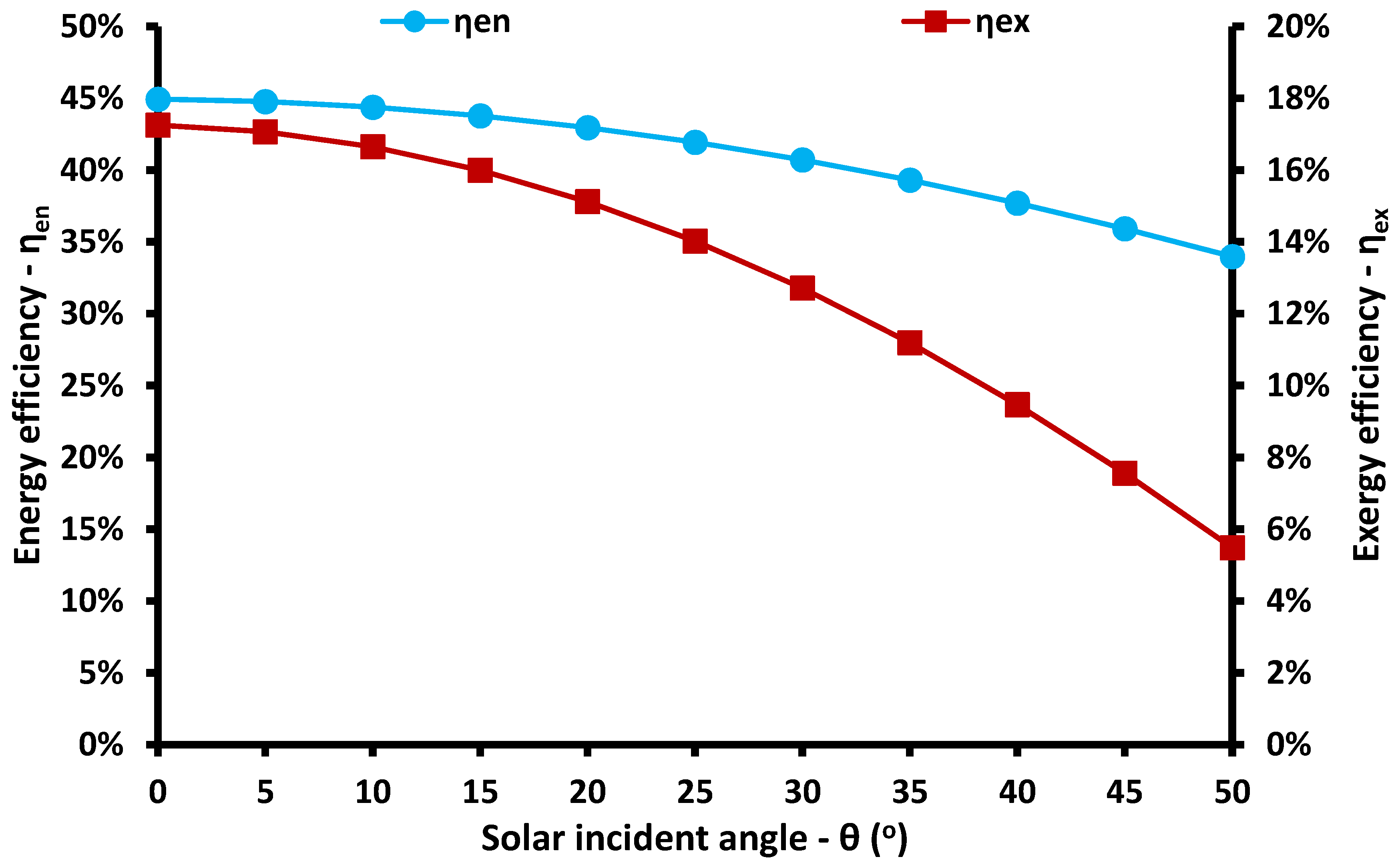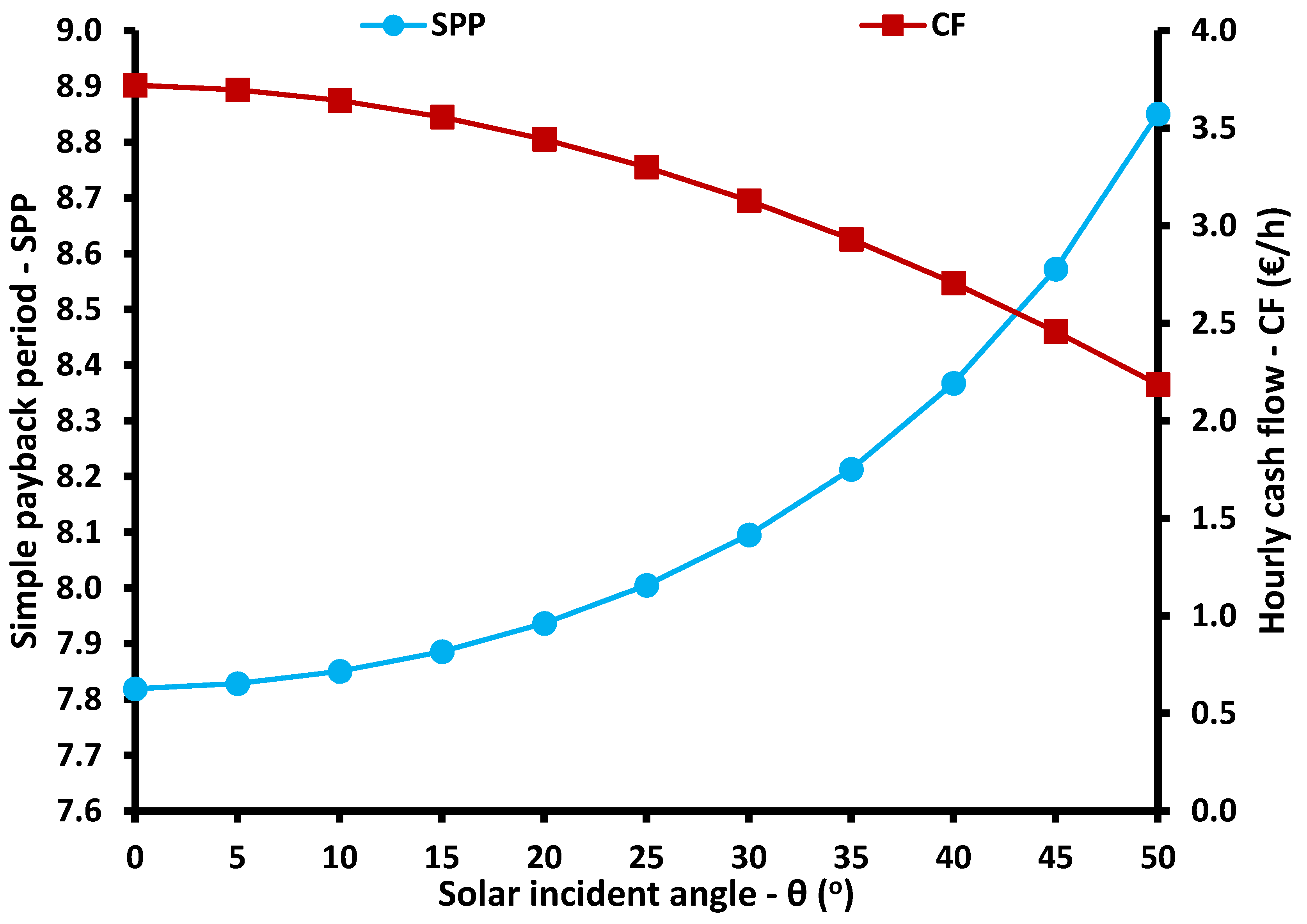Author Contributions
Conceptualization, methodology, investigation, writing—review and editing, writing—original draft preparation, E.B.; supervision, writing—review and editing, writing—original draft preparation, C.T. All authors have read and agreed to the published version of the manuscript.
Figure 1.
The examined solar-driven trigeneration system.
Figure 1.
The examined solar-driven trigeneration system.
Figure 2.
Electricity, heating, and cooling for different pressure ratio parameters.
Figure 2.
Electricity, heating, and cooling for different pressure ratio parameters.
Figure 3.
Energy and exergy efficiency for different pressure ratio parameters.
Figure 3.
Energy and exergy efficiency for different pressure ratio parameters.
Figure 4.
Simple payback period and hourly cash flow for different pressure ratio parameters.
Figure 4.
Simple payback period and hourly cash flow for different pressure ratio parameters.
Figure 5.
Electricity, heating, and cooling for different superheating levels.
Figure 5.
Electricity, heating, and cooling for different superheating levels.
Figure 6.
Energy and exergy efficiency for different superheating levels.
Figure 6.
Energy and exergy efficiency for different superheating levels.
Figure 7.
Simple payback period and hourly cash flow for different superheating levels.
Figure 7.
Simple payback period and hourly cash flow for different superheating levels.
Figure 8.
Electricity, heating, and cooling for different heating source temperature difference values.
Figure 8.
Electricity, heating, and cooling for different heating source temperature difference values.
Figure 9.
Energy and exergy efficiency for different heating source temperature difference values.
Figure 9.
Energy and exergy efficiency for different heating source temperature difference values.
Figure 10.
Simple payback period and hourly cash flow for different heating source temperature difference values.
Figure 10.
Simple payback period and hourly cash flow for different heating source temperature difference values.
Figure 11.
Electricity, heating, and cooling for different generator heat input values.
Figure 11.
Electricity, heating, and cooling for different generator heat input values.
Figure 12.
Energy and exergy efficiency for different generator heat input values.
Figure 12.
Energy and exergy efficiency for different generator heat input values.
Figure 13.
Simple payback period and hourly cash flow for different generator heat input values.
Figure 13.
Simple payback period and hourly cash flow for different generator heat input values.
Figure 14.
Electricity, heating, and cooling for different generator temperature levels.
Figure 14.
Electricity, heating, and cooling for different generator temperature levels.
Figure 15.
Energy and exergy efficiency for different generator temperature levels.
Figure 15.
Energy and exergy efficiency for different generator temperature levels.
Figure 16.
Simple payback period and hourly cash flow for different generator temperature levels.
Figure 16.
Simple payback period and hourly cash flow for different generator temperature levels.
Figure 17.
Electricity, heating, and cooling for different solar irradiation levels.
Figure 17.
Electricity, heating, and cooling for different solar irradiation levels.
Figure 18.
Energy and exergy efficiency for different solar irradiation levels.
Figure 18.
Energy and exergy efficiency for different solar irradiation levels.
Figure 19.
Simple payback period and hourly cash flow for different solar irradiation levels.
Figure 19.
Simple payback period and hourly cash flow for different solar irradiation levels.
Figure 20.
Electricity, heating, and cooling for different solar angles.
Figure 20.
Electricity, heating, and cooling for different solar angles.
Figure 21.
Energy and exergy efficiency for different solar angles.
Figure 21.
Energy and exergy efficiency for different solar angles.
Figure 22.
Simple payback period and hourly cash flow for different solar angles.
Figure 22.
Simple payback period and hourly cash flow for different solar angles.
Table 1.
Data for financial analysis [
26,
27].
Table 1.
Data for financial analysis [
26,
27].
| Parameters | Symbols | Values |
|---|
| Electricity cost | (Kel) | 0.20 € kWhel−1 |
| Heating cost | (Kheat) | 0.10 € kWhheat−1 |
| Cooling cost | (Kcool) | 0.067 € kWhcool−1 |
| PTC-specific cost | (Kcol) | 250 € m−2 |
| Tank-specific cost | (Ktank) | 1000 € m−3 |
| ORC-specific cost | (Korc) | 3000 € kWel−1 |
| AHP-specific cost | (KAHP) | 1000 € kWcool−1 |
| Operation and maintenance cost | (KO&M) | 1% of the capital cost |
Table 2.
Main parameters of the present work.
Table 2.
Main parameters of the present work.
| Parameters | Symbols | Values |
|---|
| Cooling temperature level |
(Tcool)
| 5 °C |
| Heating temperature level |
(Theat)
| 60 °C |
| Collecting area (PTC) |
(Acol)
| 100 m2 |
| Solar field flow rate |
(mcol)
| 2 kg s−1 |
| Storage tank volume |
(Vtank)
| 4 m3 |
| Tank thermal loss coefficient |
(UT)
| 0.5 W m−2 K−1 |
| Pinch point (temperature difference) |
(PP)
| 5 °C |
| Motor efficiency |
(ηmotor)
| 80% |
| Turbine isentropic efficiency |
(ηis,T)
| 85% |
| Generator efficiency |
(ηg)
| 98% |
| Mechanical efficiency |
(ηm)
| 99% |
| Solution heat exchanger effectiveness |
(ηhex)
| 70% |
| Recuperator temperature difference |
(ΔTrec)
| 10 °C |
| Condenser temperature level |
(Tcon)
| 40 °C |
| Ambient temperature |
(Tam)
| 25 °C |
| Yearly operating period |
(Time)
| 2500 h |
Table 3.
Parametric analysis data.
Table 3.
Parametric analysis data.
| Parameters | Symbols | Values |
|---|
| Default | Minimum | Maximum |
|---|
| Superheating | ΔΤsh (°C) | 20 | 0 | 40 |
| Pressure ratio | α (-) | 90% | 50% | 90% |
| Source temperature difference | ΔΤs (°C) | 0 | 0 | 40 |
| Heat input in the generator | Qg (kW) | 15 | 0 | 20 |
| Generator temperature | Tg (°C) | 115 | 110 | 130 |
| Solar irradiation | Gb (W m−2) | 700 | 400 | 1000 |
| Solar angle | θ (°) | 30 | 0 | 50 |
Table 4.
Final results for the optimized system for minimum SPP.
Table 4.
Final results for the optimized system for minimum SPP.
| Parameter | Symbols | Values |
|---|
| Energy efficiency | (ηen) | 43.30% |
| Exergy efficiency | (ηex) | 13.08% |
| Electricity production | (Pel) | 6.39 kW |
| Heating production | (Qheat) | 12.42 kW |
| Cooling production | (Qcool) | 11.49 kW |
| Yearly electricity yield | (Eel) | 15,985 kWh |
| Yearly heating yield | (Eheat) | 31,050 kWh |
| Yearly cooling yield | (Ecool) | 28,725 kWh |
| Yearly solar energy | (Esol) | 175,000 kWh |
| Simple payback period | (SPP) | 7.82 years |
| Cash flow | (CF) | 3.29 €/h |
| Pressure ratio | (α) | 0.5882 |
| Superheating degree | (ΔΤsh) | 27.81 K |
| Generator temperature | (Tg) | 130 °C |
| Yearly CO2 mitigation | (YCO2) | 35.51 tones |
Table 5.
Important ratio values of the yearly energy amounts.
Table 5.
Important ratio values of the yearly energy amounts.
| Parameter | Value |
|---|
| Power-to-heating ratio | 0.5148 |
| Power-to-cooling ratio | 0.5565 |
| Cooling-to-heating ratio | 0.9251 |
| Power-to-solar ratio | 0.0913 |
| Heating-to-solar ratio | 0.1774 |
| Cooling-to-solar ratio | 0.1641 |

